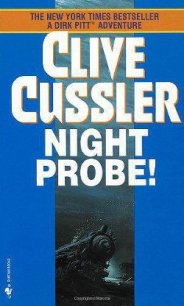The Mayan Secrets - Cussler Clive (читать бесплатно полные книги TXT) 📗
Also inside their bags were small digital spy cameras, two embedded in watches and two in clear eyeglasses. They knew that if the copy of the codex existed, they would not be able to remove it from the building, and getting permission to photograph it would be at least difficult and maybe impossible. Even worse, just asking permission would announce to the rest of the world that the copy existed and would soon reveal what it contained.
They flew first class on the transatlantic flight, and, when they arrived, they took a taxi to the Chamartin station and boarded the streamlined Alta Velocidad Espanola bullet train to Valladolid. The train took only an hour and ten minutes to cover a hundred thirty miles, including passing through a seventeen-mile tunnel. Selma had made a reservation for them at the Zenit Imperial Hotel, a fifteenth-century palace next to the Town Hall and the Plaza Mayor. She also downloaded a digital version of a guidebook to Valladolid on Remi’s iPad.
Sam and Remi spent their first day exploring the city, validating their appearance as rich tourists who had time to spare. The modern city of Valladolid is a manufacturing and communications center and a major grain market, but they entertained themselves by seeking out the old city, where the remnants of the Middle Ages still stood.
Remi read from a guidebook as they walked from place to place. “The Spanish conquered the city from the Moors in the tenth century. Unfortunately, they forgot to ask the Moors what Valladolid meant, so we don’t know.”
“Thanks for that,” said Sam. “Anything else on the list of missing facts?”
“Scads. But we do know Valladolid was the chief residence of the kings of Castile. Ferdinand and Isabella were married here and Columbus died here. Cervantes wrote part of Don Quixote here.”
“I’m impressed,” said Sam. “And I’m serious.”
Their last stop was the Colegio de San Gregorio, where Las Casas lived for several years after he returned from the New World. They walked to the front of the great stone building as Remi checked her guidebook. “The portal to the chapel — the building in front of us — was built by Alonso de Burgos, confessor to Queen Isabella, in 1488. The chapel itself was finished in 1490.” She looked down at the stones of the pavement. “So, right now, we’re standing where Columbus, Queen Isabella, and Ferdinand probably stood.”
“Not to mention Bartolome de Las Casas,” Sam said quietly. “It’s really an amazing piece of architecture.”
“Las Casas came here to live in 1551. He rented a cell in the college. During this period, he was very influential at Emperor Charles V’s court. He died in 1566, in Madrid, but left his extensive library to the college. Our next mission is to see if we can find it.”
On the other side of the street there was a gaggle of German tourists being led by a tall blond woman who was lecturing them on the sights. In the center of the group were the two men who had followed Sam and Remi to Spain, Russell and Ruiz. When Sam and Remi stepped into the entrance, Russell and Ruiz separated themselves from the German tourists and moved down the street to watch the chapel from a distance.
Sam and Remi walked through the entrance and into the chapel. It was a dream of white stone, carved and polished five hundred years ago and still the same in the echoing silence as though time had only passed by outside, not in here.
“The upper tier must be where Las Casas rented his room,” said Sam, “and where he wrote his last few books.”
They walked through the college while Remi scanned the guidebook. “Life wasn’t all pretty here,” she said. “In 1559, the Inquisition burned twenty-seven people at the stake in Valladolid. And, at one point, an enemy denounced Las Casas to the Inquisitors too, but the accusation didn’t go anywhere. When Las Casas signed over the rights to his History of the Indies to the college, he added the condition that it not be published until forty years passed. He said that if God destroyed Spain for its sins, he wanted people in the future to know what exactly they had done wrong — they had treated the Indians with such cruelty.”
“Let’s keep looking. If we find his library, maybe we can make an appointment to get in and take a look at it tomorrow,” said Sam. They continued to search and eventually found their way to a museum of Spanish sculpture. They approached the man at the desk near the entrance. “Here goes,” Remi whispered.
Remi said to him in Spanish, “Sir, do you know where we should go to see the library that Bishop Bartolome de Las Casas donated to the College of San Gregorio?”
“Yes, I do,” replied the man. “First, you must know that it’s all part of the University of Valladolid.”
“I suppose the books had to be moved to a modern university.”
The man smiled. “The university was founded in 1346. But, yes, it’s modern. It’s an active institution, with thirty-one thousand students. The College of San Gregorio is a part of it but serves mainly as a museum of art and architecture now. The monks are gone. I believe what you’re looking for is quite close by in the History Library.”
“How do we find the History Library?”
“Go down the Calle Gondomar to the main university. Outside is the patio. There are three levels set on octagonal pillars. On the right side is the chapel and on the left is a semicircular porch. Go left. The first level houses the History Library.”
As they walked to the library, Sam noticed that two men were on the same course, walking far behind them on Calle Gondomar. He wondered for a moment if they could be following him and Remi. He and Remi had, after all, put Sarah Allersby on notice that they weren’t going to let her rob them and forget it. But they were a long way from Guatemala City, and they’d just arrived in Valladolid. Could these men have followed them here already? They would have had to be watching them in San Diego practically from the time they’d come home from Guatemala, then caught the same plane or the one after it.
They reached the History Library, and Remi asked in Spanish whether they could see the collection of books that Bartolome de Las Casas had left the College of San Gregorio. They were pleasantly surprised to learn that they could sign in as visiting scholars, and a librarian would admit them, without too many intimidating formalities. They only had to prove their identities and leave Remi’s purse and their passports at the desk. When they entered a large reading room, there were already a few graduate students reading old books at tables.
A second history librarian showed them to a rare book room, gave them gloves, and allowed them to examine the volumes in the Las Casas collection for about three hours, going from one volume to the next. All of the volumes were bound or rebound in old leather. Some were hand-copied Latin or Spanish in archaic handwriting, some were incunabula — works printed before 1500—a few in medieval Gothic script with hand-painted illumination. Most were religious works in Latin. There were commentaries on the Bible, collected sermons, multiple copies of breviaries. There was a copy of the Corpus Aristotelicum. There were also Spanish volumes written or copied in a hand that was clearly the same as the writing on the letter that had been hidden in the Mayan codex. Whenever they saw one, it excited them, but none was what they had come so far to find. The treasure they searched for would consist of Mayan pictures and glyphs, not Spanish text.
At the end of the day, just before it was time for visitors to leave the library, the desk librarian made an announcement that readers should return books. The Fargos gave theirs up immediately, went to the desk to retrieve Remi’s bag, and left. As they emerged onto the patio outside the building, Remi whispered, “Have you seen those two men before?”
Sam stopped, apparently to look around him at the medieval Spanish architecture but took a moment to find the men she meant. They were already walking off in another direction. “I saw a couple of men earlier on the Calle Gondomar, but I can’t tell if those are the same ones. What did they do?”



